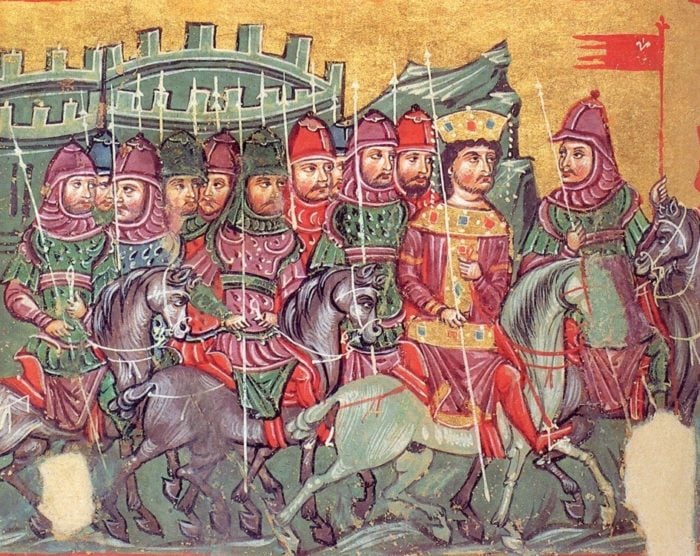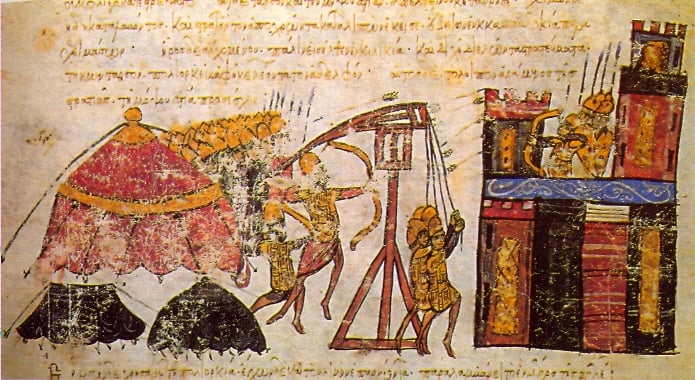
The Byzantine Army was among the most powerful and effective military forces in the world from the 7th to the 12th centuries.
Starting to operate around 395 AD, the army of Byzantium was a continuation of the mighty East Roman army, with the commander in chief being the Byzantine emperor.
Subsequently, the Byzantine army followed the structure of the Roman army, known for its strict discipline, rigid organization and skillful battle strategies.
The Byzantine Empire became one of the most important in history, linking Greece, Christian faith and Western Europe.
From the 7th to mid-9th centuries the Byzantine Army’s role was mostly defensive due to the attacks — and territorial losses — suffered from the Muslim Rashidun Caliphate.
The theme-system
To counter the more powerful Caliphate during that period, the Byzantine Army adapted the “theme”system.
The theme (or thema, from the Greek word θέμα) was an administrative division of the empire in which a general exercised both civilian and military jurisdiction and a judge held the judicial power.
Byzantium had lost almost half of its territory during the Caliphate attacks and between 659 and 662 its Army agreed to a truce with the Caliphate and regrouped.

The five original themata (plural of thema) were all in Asia Minor, comprised of earlier field armies. Specifically, they were:
The Armeniac Theme, the successor of the Army of Armenia that occupied the old areas of the Pontus, Armenia Minor and northern Cappadocia, with its capital at Amasea.
The Anatolic Theme, the successor of the Army of the East (Ανατολή). It covered central Asia Minor, and its capital was Amorium.
The Opsician Theme was where the imperial retinue (in Latin Obsequium), was established. It covered northwestern Asia Minor (Bithynia, Paphlagonia and parts of Galatia), and was based at Nicaea.
The Thracesian Theme, the successor of the Army of Thrace. It covered the central western coast of Asia Minor (Ionia, Lydia and Caria), with the capital being Ephesos.
The Carabisiani Theme, probably formed from the remnants of the Army of the Illyricum or the old quaestura exercitus. It occupied the southern coast of Asia Minor and the Aegean Islands, with its capital at Attaleia.
The latter was the naval force of the empire, replaced with the Cibyrrhaeot Theme in the early 8th century.
The imperial tagmata of the Byzantine army
Being far from Constantinople, the seat of the Empire, the themata were not as loyal to the emperor as they should be.
Emperor Constantine V formed a new force, the tagmata (“regiments”). These professional soldiers formed the army of the Empire.
The tagmata were the reformed old guard units of Constantinople, meant to provide the emperor with a strong force of loyal guards.
The tagmata were formed to suppress a major revolt in the Opsician Theme in 741–743.
The Byzantine Army changes in the 11th century
The Komnenos dynasty rule that began in 1081 (until about 1185) found the Byzantine Empire at its weakest, having lost most of its former territories and plagued by civil wars.
Alexios I Komnenos, the first of the five emperors of the Komnenian dynasty, was determined to stop the decline and revive the empire, reclaiming lost territories and expanding.
The priority of Komnenos was to restore the army completely. The theme-system was abandoned and new military priorities prevailed.
The new Komnenian army was formed with skilled guards units such as the Varangian Guard and the Immortals (a unit of heavy cavalry) stationed in Constantinople.
There was also the mighty cataphract cavalry from Macedonia, Thessaly and Thrace, and various other provincial forces from regions such as the Black Sea coast of Asia Minor.

A multi-ethnic army
The Byzantine army from the 11th century and on used foreign mercenaries extensively.
The same practice was followed by the Greek states that emerged after the conquest of Constantinople by the Crusaders in 1204, such as the Empire of Nicaea or the Despotate of Epirus.
The Byzantine Army mercenaries came from literally almost all the nations of the then-known world:
Hungarians were part of the forces of Ioannis II Komnenos in his campaign against the Seljuks. Later, in the 13th century, Hungarian warriors participated in the army of the Empire of Nicaea.
Latins, also referred to as Franks, were overwhelmingly French, while in much smaller numbers, there were Italians, Spaniards and Germans among them, serving mainly as heavily armored horsemen.
Turks (Seljuks, Ottomans, and others) were always a major part of the Byzantine Empire armies, serving as mercenaries.
Catalans were used by the Byzantines from the 1270s until the 15th century. The most typical case of such troops was the so-called “Catalan Company,” which was hired by Andronikos II Palaiologos to fight the Turks in 1302.
Alanians, an Iranian nation of Caucasus, were considered the best horsemen of the East. From the end of the 11th century until the beginning of the 14th, they supplied the Byzantines with cavalry archers.
Burgundians were part of the mix as well. In 1445, the Duke of Burgundy sent 300 warriors to strengthen the Despotate of Morea military against the Ottomans. Also, many individual Burgundian mercenaries served the Byzantine emperors throughout the 15th century.
Scandinavians also were present in the Byzantine army. The Varangian Guard was a select mercenary unit of men from various nations of northern Europe. Their mission was to guard the emperor, to whom they were devoted to the point of death.
It was a great honor for the Vikings to travel as far as Constantinople and serve in the emperor’s bodyguard. It was a service that secured fame as well as money.
Saxons and English first appeared as mercenaries of the Byzantine Army in the 1080s. From the 12th century onward, they were classified in the Varangian Guard, as a northern European nation.
During the 12th century, many Russian rulers supplied the Byzantine army with infantry warriors, seeking to maintain friendly and allied relations with Constantinople. They were classified in the Varangian Guard as well.
In the battle of Pelagonia, in 1259, the Bulgarians had a remarkable action, as mercenaries in the army of Nicaea. Until the second half of the 14th century, they participated more and more in the Byzantine forces.
Under conditions imposed on the Serbs by Constantinople in the early 12th century, they were obligated to supply the emperor with 500 horsemen for operations in Anatolia.
During the 14th century, hundreds of Albanian mercenaries were part of the Byzantine forces in Thessaly and the Peloponnese. Their number increased to 10,000 in the 1390s.
Mercenaries from the Kingdom of Georgia occasionally served as cavalry divisions in the Byzantine army, mainly in the 12th century but also in the early 13th.
Auxiliary corps of Armenian soldiers fought on behalf of the Byzantines in the 12th and 13th centuries. They were used occasionally in northern Syria and Asia Minor.
The Empire of Nicaea used Mongol auxiliary soldiers in its campaigns against the Seljuks, from 1220-1240. In 1282, 4,000 warriors of Nogai Khan, participated in the army of Michael IX, during his operations against the Latins of Thessaly.
